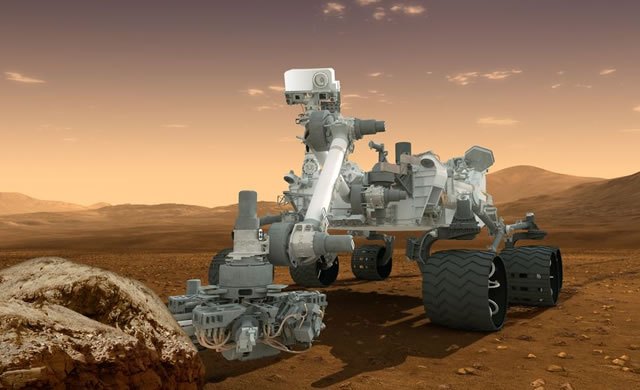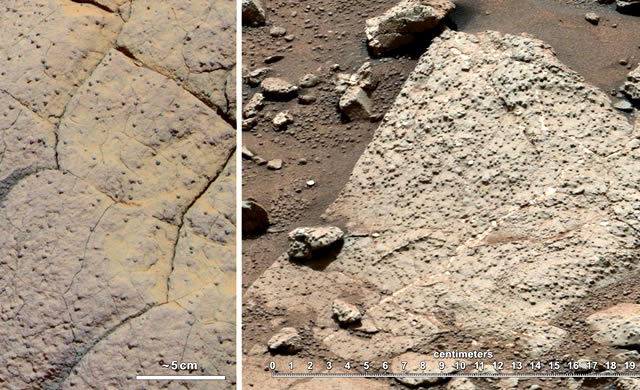
Due ambienti acquosi diversi
La notizia arriva a conferma di un sentore di cui avevamo già parlato su questo blog il 25 Febbraio scorso: Marte potrebbe avere avuto le condizioni necessarie ad ospitare la vita e queste condizioni potrebbero tutt’oggi sussistere. E pare proprio così. La conferma oggi da parte della NASA e del team di ricerca di Curiosity che riportano l’importante passo in avanti della missione marziana, anticipate dal tweet dell’account ufficiale di Curiosity. Queste due immagini a confronto delle rocce fotografate dai rover Opportunity e Curiosity della NASA, sono state riprese in due diverse parti di Marte. A sinistra la zona interessata da Opportunity nel cratere Endurance, nella Piana di Meridiani. Nella foto a destra le rocce del gruppo “Sheepbed” a Yellowknife Bay, nel Gale Crater, immortalate da Curiosity. La roccia sulla sinistra è formata da solfato ricco di arenaria. Gli scienziati ritengono che le particelle sono state parzialmente formate e cementate in presenza di acqua. Essi pensano che anche le concrezioni (dossi sferici distribuiti su parete di roccia) si siano formati in presenza di acqua. Le rocce di Meridiani rivelano un antico ambiente acquoso che probabilmente non era abitabile a causa dell’acidità estremamente elevata dell’acqua, così come la sua salinità che avrebbe impedito un qualsiasi metabolismo microbico, semmai vi fosse stata presenza di microorganismi. Nell’immagine a destra, questi sedimenti a grana molto fine rappresentano il record di un antico ambiente abitabile. I sedimenti depositati si trovavano probabilmente sotto l’acqua. Gli scienziati pensano che l’acqua abbia mantenuto i sedimenti, e anche formato le concrezioni. La roccia è stata poi fratturata e analizzata ed ha rivelato una quantità di minerali di solfato di quando l’acqua scorreva attraverso le reti di fratture del sottosuolo (linee bianche che attraversa la roccia). I dati provenienti dai diversi strumenti in dotazione a Curiosity, specie da SAM, indicano quindi un ambiente abitabile caratterizzato da pH neutro, gradienti chimici che avrebbero creato energia per i microbi, con una salinità decisamente basso, che avrebbe aiutato il metabolismo dei microrganismi qualora vi fossero stati sul Pianeta Rosso
I was sent to Mars to find evidence of past habitable environments. Achievement unlocked! [info & images] go.nasa.gov/12MeiIS
— Curiosity Rover (@MarsCuriosity) 12 marzo 2013

Two Different Aqueous Environments
This set of images compares rocks seen by NASA’s Opportunity rover and Curiosity rover at two different parts of Mars. On the left is ” Wopmay” rock, in Endurance Crater, Meridiani Planum, as studied by the Opportunity rover. On the right are the rocks of the “Sheepbed” unit in Yellowknife Bay, in Gale Crater, as seen by Curiosity. The rock on the left is formed from sulfate-rich sandstone. Scientists think the particles were in part formed and cemented in the presence of water. They also think the concretions (spherical bumps distributed across rock face) were formed in the presence of water. The Meridiani rocks record an ancient aqueous environment that likely was not habitable due the extremely high acidity of the water, the very limited chemical gradients that would have restricted energy available, and the extreme salinity that would have impeded microbial metabolism — if microrganisms had ever been present. In the Sheepbed image on the right, these very fine-grained sediments represent the record of an ancient habitable environment. The Sheepbed sediments were likely deposited under water. Scientists think the water cemented the sediments, and also formed the concretions. The rock was then fractured and filled with sulfate minerals when water flowed through subsurface fracture networks (white lines running through rock). Data from several instruments on Curiosity — the Alpha Particle X-ray Spectrometer, the Chemistry and Camera instrument, the Chemistry and Mineralogy instrument, the Mars Hand Lens Imager, the Mast Camera, and the Sample Analysis at Mars instrument — all support these interpretations. They indicate a habitable environment characterized by neutral pH, chemical gradients that would have created energy for microbes, and a distinctly low salinity, which would have helped metabolism if microorganisms had ever been present.
Source/Continue reading → jpl.nasa.gov
@marscuriosity Congratulations, great job! What’s next?
— DENEB Official © (@denebofficial) 13 marzo 2013
Tutto su Curiosity – All about Curiosity


















Pingback: L’Annuncio a proposito di Marte Aumenta il Quesito: Che cosa è la vita? – Mars Announcement Raises Question: What Is Life? | DENEB Official ©